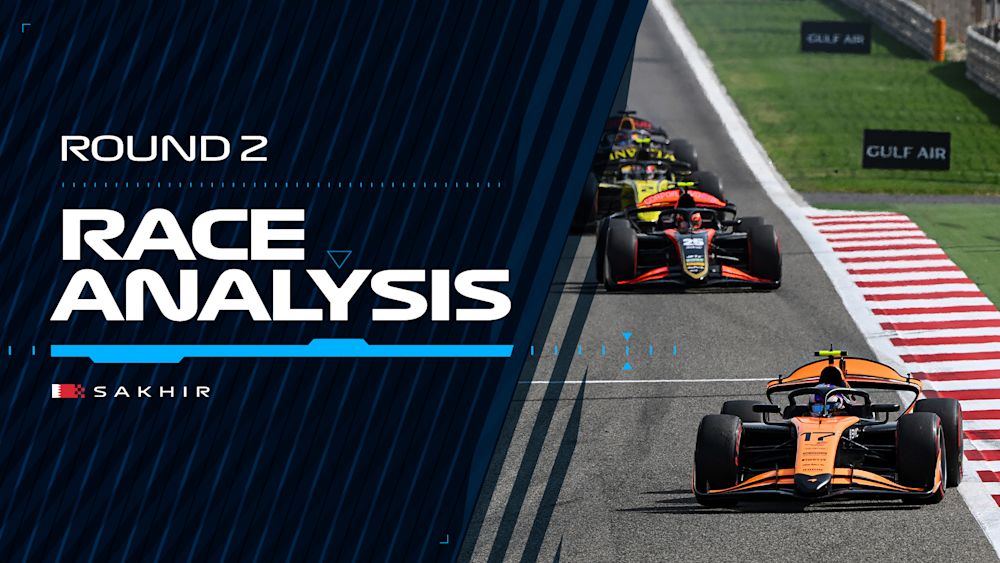Feature
RACE ANALYSIS: How Sakhir became Rodin Motorsport territory once again

After three days of in-season testing, teams arrived for Round 2 with plenty of data on the Bahrain International Circuit.
But, for the second consecutive year, one team left the rest chasing as Rodin Motorsport and Alexander Dunne were unbeatable in the Feature Race.
On a weekend that brought some thrilling racing and intriguing strategy options, how did the Rodin/Dunne combination rise to the top?
STARTING ON THE FRONT FOOT
Most of the top 10 opted to fit the red-walled Soft tyre for the start of the race on Sunday. Only Luke Browning and Richard Verschoor were on the Hards, and both fell outside the top 10 on Lap 1 as a result.
Leonardo Fornaroli converted pole into an early lead, but Dunne’s great launch put him up to P2 from fourth on the grid and in position to go chasing down the Invicta Racing driver.
Fornaroli’s pace was strong in the opening three laps, but he quickly reported that his tyres were beginning to give up their best. By Lap 5, he’d slipped into the 1:51s from the 1:50s and Dunne was into DRS range.
He couldn’t hold the Rodin driver back, and Dunne took the lead on Lap 7. Having comfortably been in the 1:50s range, he then dropped back into the 1:51s but importantly, he now had clean air.
Campos Racing’s Josep María Martí was the only driver logging similar times as the Rodin driver, but by Lap 11, Dunne was in a class of one in that 1:51-bracket.
With clear air, Dunne was able to prevent his tyres from overheating, allowing him to eke his advantage out ahead of the pitstop window and extend his first stint well beyond what other drivers on the Softs could manage.

FINDING THE BALANCE
Dunne’s impressive pace allowed him and Rodin to run long, but elsewhere, strategy calls were the focus up and down the field.
Victor Martins was brought in on Lap 12 for an aggressive undercut on Martí and Fornaroli ahead, a move that eventually worked out in the ART Grand Prix driver’s favour after the duo made their stops three laps later.
Hitech TGR meanwhile had brought Browning in for a surprisingly early switch to Softs on Lap 13. Rejoining down in 14th, he hit the Soft tyres right away and as more pitstops played out, he was able to move into the top five, using the performance of the softer compound to his advantage.
READ MORE: Luke Browning’s Sakhir Debrief: A special weekend in the desert
With overtakes on Martins and Fornaroli, he moved up to second on Lap 23, by which point Dunne had stopped for Hards and established a 5.6s lead over the Williams Racing Driver Academy talent.
Though Browning was now on the softer compound versus Dunne, the Briton’s fast start to the second stint prevented any serious challenge from being mounted, as he had to preserve his tyres to the end of the race.
The race leader measured out the performance of his Hard tyres, lapping consistently quicker than the rest of the field to the tune of a few tenths, aside from a late-stopping Arvid Lindblad.

A WINNING STRATEGY
Rodin had been here before, winning the 2024 edition of the race with a similar strategy in the hands of Zane Maloney. The Bajan driver started on Softs, extended the first stint to Lap 19 and fitted the Hards to end up dominating, sweeping both wins that weekend.
Dunne admitted on Sunday he hadn’t maximised his performance in the Sprint having been in contention for victory the day before, but more than made up for that with his maiden F2 victory.
READ MORE: Martí revels in ‘great’ Sakhir weekend as he targets Sunday victories going forward
While he hadn’t topped any of the times in the preceding test, Rodin proved once more they knew what was needed to setup the car to be quick in Sakhir whilst getting the best out of the Pirelli tyres.
The Soft compound became the tyre of choice despite the sweltering conditions in the Feature Race, though only if you could bring them in slowly and be patient in extracting the performance from them.
Once Dunne had clear air, his times dropped but were consistent, quicker than his nearest rivals to the tune of a few tenths per lap, allowing him the longest stint of drivers in contention for the win.

PUSH VERSUS PATIENCE
Once he switched to the Softs, Browning theoretically had a pace advantage but his fast opening to the second stint to gain track position meant that by the time he was into clear air, the peak of the tyre performance was gone.
Those on Hards experienced as many overheating issues as those on Softs did, but the outright pace of the white-walled harder compound was still competitive with a Soft.
It was all about how you introduced the tyre to the stint, as a measured opening few laps paid dividends by the end.
“We understood from the Sprint how quick the Option tyre was compared to the Prime, but it actually ended up being a bit contradictory,” Browning assessed afterwards.
READ MORE: GALLERY: Some moments you might have missed from Round 2 in Sakhir
“It sent us a bit in the wrong direction… the best strategy for us (was) the Prime-Option…but I think the Option-Prime was quicker overall today.
“It was a little bit contradictory, we didn't expect the Prime to be as strong as it was, but I think we made the most out of our strategy and we were one of the only ones to make it work.”
On the other side of the strategic table, Dunne and Rodin proved too quick for rivals to catch. His maiden F2 win was an impressive showing of teamwork and confidence at the wheel, and Rodin once again proved to have a great understanding of the abrasive Bahrain International Circuit.